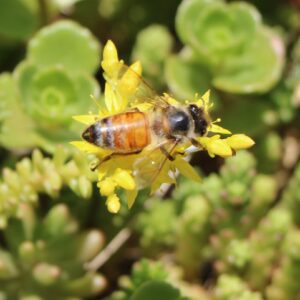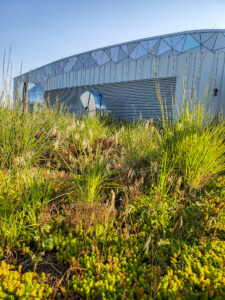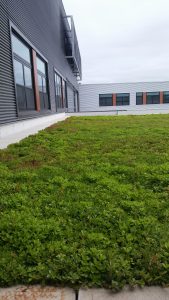Toward a Sustainable Future: Green Roofs and LEED Credits

A honeybee collects nectar from sedums on green roof. © NLSM
Achieve Your LEED Goals with a Green Roof
Healthy People in Healthy Places
The COVID-19 pandemic has magnified the world’s great need for safe and healthy spaces.
For two years in a row (2018 and 2019) Canada ranked 2nd in USGBC’s global list of top 10 countries and regions for Leadership in Energy and Environmental Design (LEED) certified projects outside of US. Canada’s public sector has taken the lead to require different levels of LEED certifications for public buildings, which has spurred greener buildings in private sector.
LEED is the Most Widely Used & Recognized Green Building Rating System
LEED is a green building rating system developed by the US Green Building Council (USGBC). Points are allocated for green building strategies in several categories. A project earns points to achieve one of 4 LEED rating levels – Certified, Silver, Gold and Platinum.

An accessible green roof at Halton Hills Austin Operations Centre, Georgetown, ON. © NLSM
How to Achieve Your LEED Goals with a Green Roof
We have summarized the different categories and the potential LEED credits that green roofs are involved, based on LEED v4.1 Building Design and Construction (April 9, 2021). As you design your green roof, keep these LEED categories in mind to maximize your LEED points.
Note that the point(s) indicated below are the maximum allowable for a particular credit. NLSM green roof systems can contribute to some or all of the points, alone or in combination with other measures.
Sustainable Sites (SS) – Multiple Benefits
SS Credit: Protect or Restore Habitat
Point(s): 1-2
Use vegetated roofs with native or adapted plants to restore 15-25% of total site area to provide habitat
SS Credit: Open Space
Point(s): 1
Use vegetated roofs to achieve a minimum of 25% outdoor vegetated space that is physically accessible
SS Credit: Rainwater Management
Point(s): 1-3
Use vegetated roofs, alone or in combination with other Low Impact Development or Green Infrastructure tools, to reduce site runoff and improve water quality.
SS Credit: Heat Island Reduction
Point(s): 1-2
Option 1. Nonroof and Roof: Use vegetated roof, alone or in combination with other tools, to meet the following criterion:

Option 2. Parking under Cover: Use vegetated roof to cover a minimum of 75% of parking spaces

Green roof on the Bergeron Centre for Engineering Excellence, York University in Toronto, ON. © NLSM
SS Credit: Site Master Plan (Applies to Schools)
Point(s): 1
Vegetated roofs contribute to the minimum 4 SS credits required to ensure sustainable site benefits.
SS Credit: Places of Respite (Applies to Healthcare)
Point(s): 1
Use vegetated roofs to create accessible outdoor natural environment and provide health benefits
SS Credit: Direct Exterior Access (Applies to Healthcare)
Point(s): 1
Use vegetated roofs to create accessible outdoor natural environment and provide health benefits
Water Efficiency (WE)
WE Credit: Outdoor Water Use Reduction
Point(s): 1-3
Use vegetated roofs that utilize regionally adapted, heat and drought resistant vegetation that require no or reduced irrigation.

Student classrooms view of a green roof at Charles P. Allen High School in Bedford, NS. © NLSM
Energy and Atmosphere (EA)
EA Credit : Optimize Energy Performance
Point(s): 1-20
Vegetated roofs mitigate heat flow through the roofing system by shading, insulation, evapotranspiration and thermal mass, contributing to improved energy performance of the building.
Materials and Resources (MR)
MR Credit: Sourcing of Raw Materials
Point(s): 1-2
Vegetated roof systems that contain recycled contents and have production sites located near major cities that can supply within 160 km (100 miles) of project sites can contribute to this credit.
Regional Priority (RP)
RP Credit: Regional Priority
Point(s): 1-4
Vegetated roofs can contribute to these credits that have been identified by the USGBC regional councils and local chapter as having additional regional importance based on geographical locations.


 NLSM has supplied more than 2.5 M SQFT coast to coast
NLSM has supplied more than 2.5 M SQFT coast to coast
Comments are closed.